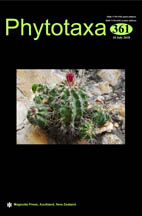Abstract
Ottelia guanyangensis (Hydrocharitaceae), a new species from southwestern China, is described and illustrated. This aquatic plant is a perennial, submersed herb with bisexual flowers and a hexagonal-cylindric fruit. It is related to O. acuminata var. songmingensis and O. balansae but differs from these two taxa by its bisexual flowers, spathe with 2–5 flowers, trinerved leaf with obvious cross veins, and a winged, hexagonal-cylindric fruit. Molecular phylogenetic analysis based on nuclear DNA internal transcribed spacer (ITS) sequences and three chloroplast DNA sequences (rbcL, trnK5’ intron and trnS-trnG) resolves O. guanyangensis as a distinct clade, which further justifies its recognition as a new species.

